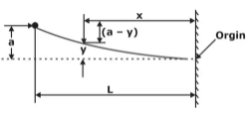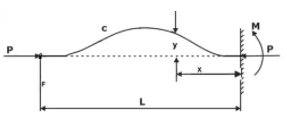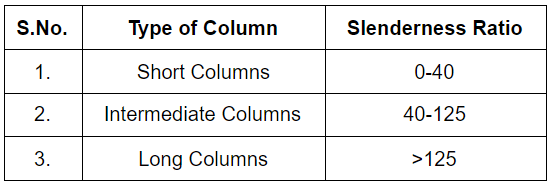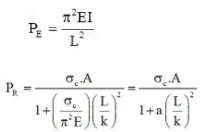Euler's Theory of Columns | Strength of Materials (SOM) - Mechanical Engineering PDF Download
Columns and Struts
- A structural member subjected to an axial compressive force is called strut. As per definition strut may be horizontal, inclined or even vertical.
- The vertical strut is called a column.
Euler’s Column Theory
Assumptions of Euler's theory:
Euler's theory is based on the following assumptions:
(i) Axis of the column is perfectly straight when unloaded.
(ii) The line of thrust coincides exactly with the unstrained axis of the column.
(iii) Flexural rigidity El is uniform.
(iv) Material is isotropic and homogeneous.
Limitation of Euler’s Formula
- There is always crookedness in the column and the load may not be exactly axial.
- This formula does not take into account the axial stress and the buckling load is given by this formula may be much more than the actual buckling load.
Euler’s Buckling (or crippling load)
The maximum load at which the column tends to have lateral displacement or tends to buckle is known as buckling or crippling load. Load columns can be analysed with the Euler’s column formulas can be given as

where, E = Modulus of elasticity, Le = Effective Length of column, and I = Moment of inertia of column section.
(i) For both end hinged
 in case of Column hinged at both end Le = L
in case of Column hinged at both end Le = L


in case of column one end fixed and other free: Le = 2L


in case of Column with both end Fixed Le = L / 2
 in case of Column with one end fixed and other hinged Le = L / √2
in case of Column with one end fixed and other hinged Le = L / √2


Slenderness Ratio (S)
The slenderness ratio of a compression member is defined as the ratio of its effective length to least radius of gyration.
slenderness (s) = Le / k = Effective length of member / Least radius of gyration


Rankine proposed an empirical formula for columns which coven all Lasts ranging from very short to very long struts. He proposed the relation
1 / PR = 1 / PC + 1 / PE
Pc = σC. A = ultimate load for a strut
Eulerian crippling load for the standard case

Where a = Rankine's constant = 
|
37 videos|39 docs|45 tests
|
FAQs on Euler's Theory of Columns - Strength of Materials (SOM) - Mechanical Engineering
| 1. What is Euler's Theory of Columns in mechanical engineering? |  |
| 2. What are the assumptions made in Euler's Theory of Columns? |  |
| 3. How is the critical buckling load determined in Euler's Theory of Columns? |  |
| 4. What is the significance of Euler's Theory of Columns in mechanical engineering? |  |
| 5. Can Euler's Theory of Columns be applied to all types of columns? |  |

|
Explore Courses for Mechanical Engineering exam
|

|


















